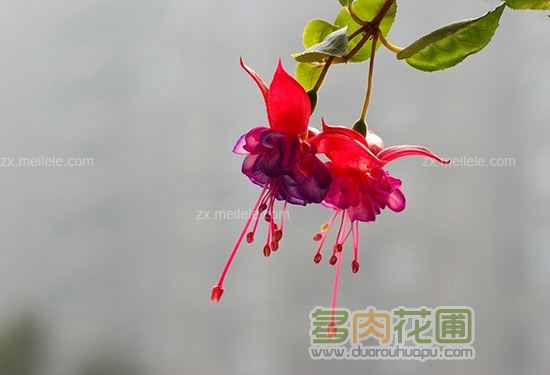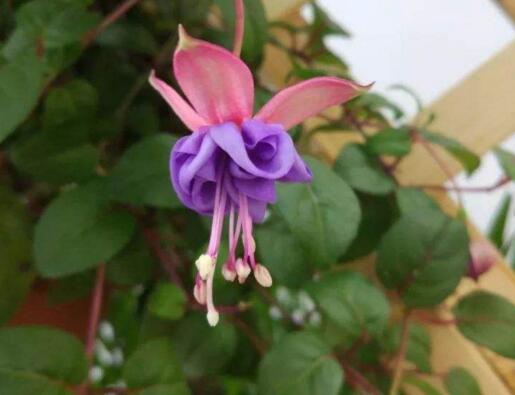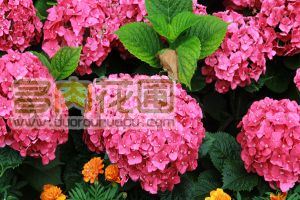The breeding method of hanging Golden Bell upside down
Native to tropical America and new Zealand. Enjoy a cool and humid environment. It is not resistant to high temperature, and the growth temperature is 10~15℃. Rich in humus, good drainage of fertile sandy loam is appropriate.
1. propagation method
(1)Sowing and propagation Some varieties easy to bear fruit can be sown and propagated. In spring and autumn greenhouse, seedlings are sown in seedling trays. By broadcasting method, they germinate in about 15 days under the temperature condition of 15~20℃. The flowers can be flowered in the second year of spring sowing.
(2)Cuttage propagation is easy to take root, and the survival rate of annual branch cuttings is the highest. Cuttings are generally carried out in spring and autumn. Cut the top shoots with a length of 5~8cm for cuttings, keep 2 leaflets, cut off the rest, and then insert them in the plain sand. 1.2 cm can be buried. It is necessary to shade and keep moisture. Under the temperature of 15~28℃, all the cuttings could take root in about 15 days. In summer, the cuttings often rotted and died, and the survival rate was low.
(3)Tissue culture can be used shoot tip and top tender leaves as explants for tissue culture propagation.
2. cultivation and management
Fuchsia fast-growing, flowering more, in the growth period should strengthen the supply of fertilizer and water. Except for no fertilization in hot summer, fertilization was applied every 10~15 days at other times. Fuchsia like cold environment, more than 30℃ is semi-dormant state. In summer, plants should be placed under shade sheds, often spraying leaves or sprinkling water on the ground to strengthen ventilation. Control watering to make it dormant over summer.
The cultivation method of inverted golden bell The cultivation method of inverted golden bell
The name of the inverted golden bell flower comes entirely from its appearance characteristics. It is not like peony, rose, tulip and other flowers. The flower bowl hangs upward, but hangs downward on the branches, just like a tripod hanging big bell. Because of this appearance, the inverted golden bell flower is also very easy to identify.
[Recommended reading] Lily longevity flower thousand red gardenia Clivia lucky head Platycodon grandiflorum mulberry spring flower mimosa
A method for breeding the inverted golden bell flower----------------------------------------------

[Plant Archives]----------------------------------------------
Chinese Name: Fukuda
Filed to: Fuchsia
Other names: Lantern Begonia, Bell Begonia
Family: Onagraceae
Filed to: Fuchsia
Origin distribution: Origin Peru, Chile, Argentina, Bolivia, Mexico and other Central and South American countries, is widely cultivated.
Configuration characteristic: Half bush or small bush, plant height 30-150 cm, bine is close smooth, branch is slender slightly drooping, often take pink or purplish red. Leaves opposite or trifoliate, ovate to ovate-lanceolate, flowers solitary in upper axils of branches, long pedunculate and pendulous. Petals 4, often embrace shape or slightly open, also have semi-double valve. Petals are red, white, purple, etc., calyx is also red, white points. Flowering from April to July.
- -------------
Fuchsia like wet, cool environment, to fertile loose slightly acidic soil is appropriate, afraid of high temperature and strong light. Summer should be dry, cool and semi-cloudy; winter should be warm and humid, sunny and ventilated. The suitable growth temperature of Fuchsia sinensis is 15-25℃, the temperature is not lower than 5℃ in winter, the growth is slow when it reaches 30℃ in summer, and it withers and dies at 35℃.
- -------------
Fuchsia fuchsia is propagated mainly by cuttage method, generally in January, February and October cuttage, cuttage temperature is 15-20℃, about 20 days to root. Liquid fertilizer is applied once every 7-14 days during the growth period of fuchsia. Fuchsia upside down phototaxis is strong, to often turn basin to maintain uniform appearance.
- --------------------------
① pot change and pot turning: The inverted bell needs to turn over the pot once before sprouting in spring or autumn every year. It can be mixed evenly with rotten leaf soil, sandy loam, decomposed organic fertilizer and phosphorus fertilizer.
② Fertilization: To master the skills of thin fertilizer and frequent application, apply thin cake fertilizer or compound fertilizer once every 10 days, apply phosphorus and potassium-based liquid fertilizer once a month during flowering, and stop applying in high temperature season.
Temperature: cool down in summer; require sufficient sunshine in winter and take insulation measures. Winter and summer, pay attention to ventilation.
④ Watering: hang upside down golden bell watering should see dry namely water, water and thorough, but avoid accumulated water. In summer, it is better to be dry, but spray water on leaves and ground to increase air humidity.
5. Placement: In order to keep the plant type plump, the position should be changed frequently, so as not to deviate from one side and destroy the plant type. However, during flowering should be less moving, otherwise it will cause bud drop flowers.
"Conclusion: After introducing the information about the Inverted Golden Bell Flower, do you recognize this flower that has a very unique appearance? Inverted golden bell flower can be cultivated indoors. After learning the cultivation method of inverted golden bell, buy a pot to raise it!
[More Plant Encyclopedia]
Poppy, Evening Primrose, Azalea, Lavender, Asparagus, Douban, Hyacinth, Flamingo, Cherry Blossom, Posthouse Lotus.
African Jasmine Rose Spring Festival Flower Succulent Tropical Plant Tequila Flower Canna Flower Forget-Me-Not Dandelion
Dendrobium officinale Taxus kapok Osmanthus flower Begonia flower hydroponic plant home Feng Shui plant bedroom Feng Shui plant plum aloe
Jasmine radiation-proof plant copper flower potted plant bonsai production drug plant mistletoe indoor flowers fortune tree evergreen rich bamboo
Potted production Anthurium mint raw stone flower geranium garden crab claw orchid smooth sailing tiger orchid Kunlun snow chrysanthemum water lily blue enchantress
The breeding method of inverted golden bell
You may not know that there is a plant called fuchsia, the shape of the more strange plants belong to succulent plants. People who like succulent plants must have known about the inverted bell bar, below we will share with you some of the inverted bell breeding methods.
The breeding method of inverted golden bell
1. What is the inverted bell
Fuchsia is a meat-rich plant, the plant height can reach 30 cm or so, there are many branches and stem nodes. This plant grows branches at the top, slender and develops rounded edges on the outside. The color of the fuchsia is light green, and the flowers are yellow. Fuchsia is a plant lover's income.
II. Cultivation method of inverted golden bell_environment
Fuchsia like warm and dry growth, cultivation of many places. Succulent shrubs such as fuchsia start to sleep in the summer, so they are less resistant at this time.
III. Cultivation method of inverted fuchsia_cutting
During the growth process, you can cut off a branch and carry out cuttage. Do not water it immediately after inserting it into the soil. Let the plant adapt, otherwise the plant will become more susceptible to decay. Just cuttage plant resistance is weak, so choose tender head for cuttage.
IV. Cultivation method of inverted golden bell_temperature
The bell began to dormancy at high temperature in summer, so proper shade treatment should be carried out. Long-term sun exposure will cause the plant to dry up. Watering and ventilation and thin fertilizer will enhance the planting effect of fuchsia.
- Prev

How to propagate cuttings of Admiralty upside down?
Upside down Admiralty is a perennial evergreen subshrub of Salicaceae, alias bell flower, lantern flower, lantern crabapple, hanging bell crabapple and so on. Hang Admiralty upside down, like hanging colorful lanterns, graceful and colorful. The flowering period is long, suitable for potted plants, and can be used to decorate flower beds in cool summer areas.
- Next

How to propagate hydrangea by bud insertion?
Hydrangea is the so-called fighting ball and hydrangea. This shade-tolerant ornamental plant usually propagates by cutting. The reproduction coefficient of this method is low. In order to propagate hydrangea rapidly, this paper introduces the method of propagating hydrangea with high propagation coefficient and bud insertion. Spring
Related
- Fuxing push coffee new agricultural production and marketing class: lack of small-scale processing plants
- Jujube rice field leisure farm deep ploughing Yilan for five years to create a space for organic food and play
- Nongyu Farm-A trial of organic papaya for brave women with advanced technology
- Four points for attention in the prevention and control of diseases and insect pests of edible fungi
- How to add nutrient solution to Edible Fungi
- Is there any good way to control edible fungus mites?
- Open Inoculation Technology of Edible Fungi
- Is there any clever way to use fertilizer for edible fungus in winter?
- What agents are used to kill the pathogens of edible fungi in the mushroom shed?
- Rapid drying of Edible Fungi

